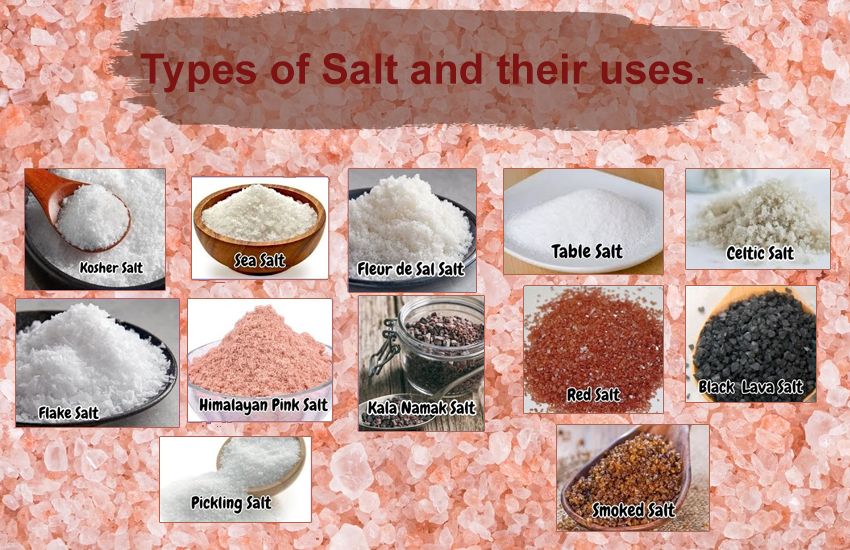Salt, an essential mineral for human health and a key culinary ingredient, comes in various types, each with distinct characteristics and uses. Here is a detailed explanation of the different types of salt:
- Table Salt
Description: Table salt is the most common type of salt used in households. It is highly refined and finely ground, often containing additives to prevent clumping.
Uses:
- General cooking and baking
- Preserving foods
- Seasoning at the table
Characteristics:
- Contains anti-caking agents
- Often iodized to prevent iodine deficiency
- Sea Salt
Description: Sea salt is produced through the evaporation of seawater. It is less processed than table salt and retains trace minerals that can affect its flavor and color.
Uses:
- Cooking and finishing dishes
- Seasoning
Characteristics:
- Coarser texture compared to table salt
- Can vary in color depending on the mineral content
- Contains trace minerals like magnesium, calcium, and potassium
- Himalayan Pink Salt
Description: Mined from ancient sea beds in the Himalayas, this salt is known for its distinctive pink color due to trace minerals like iron.
Uses:
- Cooking and seasoning
- Bath salts and spa treatments
- Salt lamps
Characteristics:
- Contains over 84 trace minerals
- Coarse or fine grain
- Pink hue
- Kosher Salt
Description: Kosher salt is a coarse-grained salt named for its use in the koshering process of meats. It is free of additives and has a flaky texture.
Uses:
- General cooking
- Koshering meats
- Seasoning
Characteristics:
- Larger, irregular grains
- Dissolves easily
- Clean, straightforward flavor
- Celtic Sea Salt
Description: Harvested from the coastal regions of France, Celtic sea salt is moist and grayish in color. It is rich in minerals and harvested using traditional methods.
Uses:
- Cooking and seasoning
- Health and wellness applications
Characteristics:
- Moist texture
- Gray color due to clay and sand
- Rich in minerals like magnesium
- Fleur de Sel
Description: Often referred to as the “flower of salt,” fleur de sel is a rare and expensive salt harvested from the surface of salt ponds in specific regions, particularly in France.
Uses:
- Finishing salt for gourmet dishes
Characteristics:
- Delicate, flaky crystals
- Moist texture
- Subtle flavor
- Black Salt (Kala Namak)
Description: Black salt, or kala namak, is a volcanic rock salt used primarily in South Asian cuisine. It has a distinctive sulfurous aroma and flavor.
Uses:
- Flavoring for Indian dishes
- Chaat masala and other spice blends
Characteristics:
- Dark reddish-black color
- Sulfurous taste and smell
- Contains iron and other minerals
- Red Hawaiian Salt (Alaea Salt)
Description: Red Hawaiian salt, known as alaea salt, is unrefined sea salt mixed with a red volcanic clay called alaea, which gives it its characteristic color.
Uses:
- Traditional Hawaiian dishes
- Grilling and roasting
Characteristics:
- Red color from iron-rich clay
- Coarse texture
- Earthy flavor
- Smoked Salt
Description: Smoked salt is sea salt that has been smoked over wood fires, infusing it with a smoky flavor.
Uses:
- Finishing salt for meats, vegetables, and dishes where a smoky flavor is desired
Characteristics:
- Varies in color from light to dark brown
- Distinct smoky aroma and taste
- Pickling Salt
Description: Pickling salt is a pure, fine-grained salt without additives, used specifically for pickling and preserving foods.
Uses:
- Pickling vegetables and fruits
- Brining
Characteristics:
- No anti-caking agents
- Dissolves easily in water
Conclusion
Each type of salt has unique properties that make it suitable for specific culinary and health applications. Understanding the differences between these salts can enhance your cooking and help you choose the right salt for your dietary and wellness needs.


